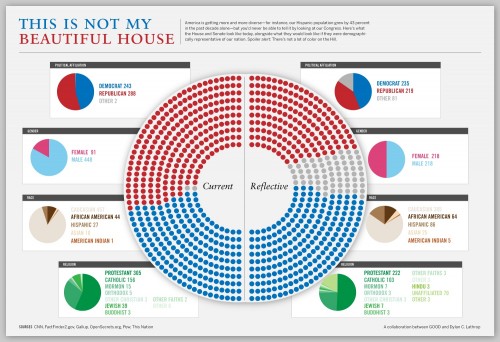Cross-posted at Caroline Heldman’s Blog.
“Transformers: Dark of the Moon,” the third installment in this $1.5 billion franchise that just set a new record for a Fourth of July weekend opening, follows what has become a Hollywood action movie tradition of virtually erasing women, despite the fact that women buy 55% of movie tickets and market research shows that films with female protagonists or prominent female characters in ensemble casts garner similar box office numbers to movies featuring men.
Only two featured characters in the large ensemble Transformers cast are women, and none of the Transformers (alien robots, for the uninitiated) are female. And the two female humans consist of an unmitigated sexual object and a caricatured mockery of female leadership.
Let’s start with “the object,” Carly (Rosie Huntington-Whiteley), the one-dimensional, highly sexualized damsel-in-distress girlfriend of protagonist Sam Wikwiki (Shia LaBouef). Carly wears stiletto heels, even when running from murderous machines (except when the filmmakers slip up and her flats are visible), and she is pristine in her white jacket after an hour-long battle that leaves the men filthy.
The movie opens with a tight shot of Carly’s nearly bare ass as she walks up the stairs:
[youtube=http://www.youtube.com/watch?v=YC32Bw9uYho]
In a later scene, Carly is reduced to an object as her boss (Patrick Demsey) compares her to an automobile in a conversation with Sam:
[youtube=http://www.youtube.com/watch?v=p2WI7f9eeUM]
And in case the audience doesn’t know to leer at Carly, they get constant instruction from a duo of small robots that look up her skirt and Sam’s boss (John Malkovich) who cocks his head to stare at her ass:
[youtube=http://www.youtube.com/watch?v=byC8cmWg6K8]
Sam’s “friend,” Agent Simmons (John Turturro), also ogles Carly and suggests she be frisked against her will:
[wpvideo ojm7ZvjZ]
In a disturbing scene of sexualized violence, Carly’s (robot) car sprouts “arms” and threatens to violate her:
[youtube=http://www.youtube.com/watch?v=t-yEghxhpMk]
Normalization of female objectification causes girls/women to think of themselves as objects, which has been linked to higher rates of depression and eating disorders, compromised cognitive and sexual function, decreased self-esteem, and decreased personal and political efficacy. Ubiquitous female sexual objectification also harms men by increasing men’s body consciousness, and causes both men and women to be less concerned about pain experienced by sex objects.
Transformers 3 is pitched as a “family movie” and the film studio carefully disguises it as such with misleading movie trailers showing a story about kid’s toys. (Okay, I still have an Optimus Prime robot…) Young kids were abundant at both screenings I attended, taking in the images with little ability to filter the message.
************
It would have been easy for Michael Bay to positively present the second female character, Director of National Intelligence Charlotte Mearing (Frances McDormand). Instead, she is a tool to openly mock female leadership and promote female competition.
McDormand does her best to breathe some realism into Director Mearing, but the script calls for a caricature with “masculine” leadership traits – arrogance, assertiveness, stubborness, etc. – who is ultimately “put in her place” at the end of the movie with a forced kiss. Women continue to be vastly under-represented in positions of corporate and political leadership, partially due to the double-bind of women’s leadership where, in order to be considered acceptable leaders, women have to project a “masculine” image for which they are then criticized.
Director Mearing’s authority is challenged by virtually everyone she encounters in a way that simply wouldn’t make sense for a male character in her position. Sam openly challenges her in this scene:
[youtube=http://www.youtube.com/watch?v=BYahdFFjZXk]
Director Mearing’s authority evaporates when Agent Simmons comments, “moving up in the world, and your booty looks excellent”:
[youtube=http://www.youtube.com/watch?v=eb4m0JuROnU]
Director Mearing is even challenged by a transformer. [SPOILER ALERT: Director Mearing is the only one to challenge this transformer’s intentions, and she gets no credit when it turns out she was right.]
[youtube=http://www.youtube.com/watch?v=aEz8DOa9I78]
This Transformer again puts her in her place with the dual meaning of “I am a prime. I do not take orders from you”:
[wpvideo EDGYfp2T]
Director Mearing also has a running theme of not wanting to be called “ma’am.”
[youtube=http://www.youtube.com/watch?v=srsWDT6w8HI]
The “ma’am” theme doesn’t readily make sense since Director Mearing isn’t young and doesn’t appear to be trying to look young. But it does make sense when viewed through the lens of director Michael Bay intentionally mocking women’s leadership. Remember the flap when Senator Barbara Boxer at a hearing requested that a general use her professional title instead of “ma’am”?:
[youtube=http://www.youtube.com/watch?v=f0CprVYsG0k]
The “ma’am” theme resurfaces in a particularly troubling scene where Director Mearing meets with Sam and Carly, who, in good double-bind fashion, challenges whether she is even a woman:
[youtube=http://www.youtube.com/watch?v=VIZOWPaoiDk]
Bay does include a few minor female characters with lines – Sam’s mother, the nagging mother/wife; Director Mearing’s subservient Asian assistant; a scene with both the “Olga” and “Petra” Russian woman stereotypes; and a Latina with a bare midriff who has a “Latin meltdown”:
[wpvideo pLgrLBNm]
If Michael Bay can buy off the most accomplished actors and even musician/social activist Bono to participate in such harmful media, what hope is there in the war that pits girls/women (the Autobots) against unrepentantly sexist movies makers (the Deceptacons)?













